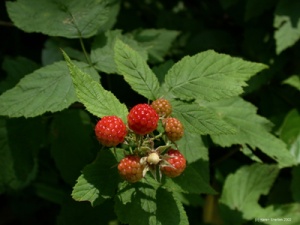Rubus idaeus
| See Also | Botanical Monographs |
|---|
Raspberry Leaf (Rubus idaeus) is a mild and safe medicinal food. It is commonly used to treat diarrhea, colds, and stomach complaints. Traditional lore suggests that pregnant women use raspberry leaf tea, especially as an aid in delivery. To explore the characteristics, medicinal uses and prescribing considerations of this herb in more detail, check out the references indicated.[1] [2]
Contents
Characteristics
- Common Names: Red raspberry, Wild raspberry, Hindberry, Raspberry Leaf
- Family: Rosaceae
- Habitat: Rubus idaeus is native to Europe and Asia, with wide spread wild growth in temperate areas. It prefers sunny locations and slightly acidic soil.
- Parts Used: Leaves, fruit
- Constituents: Leaf - tannins, flavonoids, polypeptides; Fruit - fruit sugar, volatile oil, pectin, citric acid, malic acid, vitamins A, B1, C
- Medicinal Actions: astringent, tonic, antidiarrheal, antipyretic, emmenagogue, parturient and partus preparator: strengthens contractions, reduces hemorrhage during labour, encourages easy labour (possibly by strengthening longitudinal uterine muscle fibers)
Uses
Historical Uses:
Traditionally in Europe, the flowers of the Rubus idaeus plant have been bruised and mixed with honey for use during eye inflammations, fever, and boils. The plant has also been used for such conditions as aphthous ulcers, wounds, bleeding gums, sore throats, and other oral cavity inflammations (gargle), and conjunctivitis (eyewash). Historically is has been used as a femal tonic to alleviate menstrual cycle discomfort and facilitate childbirth.
Medicinal Uses:
- a women's tonic to strengthen and tone the uterus and the pelvic muscles
- dysmenorrhea, menorrhagia, leucorrhea
- oral cavity inflammations such as aphthous ulcers, wounds, bleeding gums, sore throats and others (gargle)
- conjunctivitis (eyewash)
- Other Conditions
Prescribing Considerations
The information provided is intended to augment the treatment from a naturopathic doctor or other trained medical professional. Although most herbs are generally safe, it is recommended that you avoid self-prescribing especially when there is an underlying ongoing medical condition, if you are on any prescription medications or if you are pregnant or breastfeeding.
Formulations and Preparation
Safety
- Generally regarded as safe.
The safety and prescribing considerations for this herb include:[3] [4]
- Side-effects are not generally seen.
- Contraindicated in pregnancy with a history of precipitate labour (empirical) and in early stages of pregnancy.
- Safe to use in the last three months of pregnancy.
- Drug-Herb Interactions.[2]
- Anticoagulants - may accelerate coagulation with internal use (speculative, ex vivo)
- Iron, Copper, Manganese, and Vitamin E Supplementation - it is rich in these elements
- Liver Metabolism - inhibition of liver CYP isozymes and induction of liver phase II conjugation
- Alkaloids and Minerals - selective precipitation by the tannins
References
- ↑ Boon Heather, Smith Michael (2009) 55 Most Common Medicinal Herbs: The Complete Natural Medicine Guide Second Edition Institute of Naturopathic Education and Research, CCNM Toronto.
- ↑ 2.0 2.1 Godfrey Anthony, Saunders Paul, Barlow Kerry, Gowan Matt (2011) Principles and Practices of Naturopathic Botanical Medicine, Advanced Botanical Medicine. V3 CCNM Press, Toronto.
- ↑ Stargrove Mitchell Bebell, Treasure Jonathan, McKee Dwight L (2008) Herb, Nutrient and Drug Interactions: Clinical Implications and Therapeutic Strategies.
- ↑ Brinker Francis (1997) Herbal Contraindications and Drug Interactions: Plus Herbal Adjuncts With Medicines, 4th Edition Eclectic Medical Publications.
